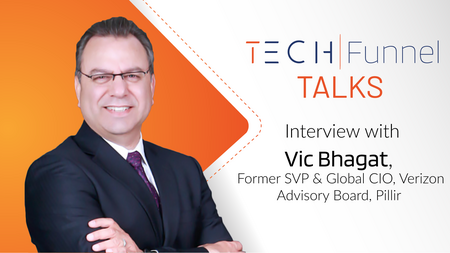Vic Bhagat was Senior Vice President and Global CIO with Verizon Enterprise. He currently serves as a senior advisor to Kyndryl/IBM. His career spanned 20 years in various divisions at GE, including as CIO, plus additional years as global CIO at storage giant EMC until it was acquired by Dell. Due to his decades of B2B and high-tech industry leadership, Bhagat is an influential strategist focused on transforming large-scale companies into modernized, cloud-ready organizations. His goal is to assist enterprises in their quest for innovation, leveraging and driving the adoption of new technologies to escalate growth with efficiency and simplicity. Learn more about Pillir. Connect with Vic here.

In this conversation, Vic Bhagat shares his insights on helping organizations invest in digital transformation, barriers companies face in cloud modernization and his role on the advisory board of Pillir.
TF: Why is digital transformation a necessary disruption for many organizations?
Vic Bhagat: Digital transformation involves learning how to leverage digital assets to streamline an organization’s processes. Everybody is looking to accomplish this, from small companies to large enterprises. The fundamental thing about this transformation is that it makes it easier for your constituents to do business with you.
Whether you’re accessing business processes from a mobile device, through the web, remotely—whatever the preference—constituents should be able to seamlessly leverage the medium they choose to interact with that company, or within that company.
Cloud-based infrastructures can make it easier for employees to communicate and share data and be part of the fabric of an organization. That helps to make operations easier. With that digital transformation comes automation, where processes that were done manually can now be done electronically, without intervention. That brings in elements like AI, machine learning, and low-code integration. Low-code/no-code basically understands what the business process needs to do, and accomplishes that automatically, kind of like a bridge to the full integration.
TF: How can organizations figure out their business strategy before investing in digital transformation efforts?
Vic Bhagat: Organizations must identify their “as-is” business process before they attempt to design a “to-be” state. During this discovery process, you must challenge the status quo and all bureaucratic and repetitive tasks. Low-code needs to be part of this strategy. Typically, every time a major ERP application is upgraded through traditional integration, it entails massive amounts of work.
You must understand the process you’re trying to support, then write code, implement code, upgrade code over time. This can make transformation a huge project that can go anywhere from six months to multiple years. Hence, with a low code/no-code solution, it’s easier to implement significant changes for software applications without hindering ongoing version upgrades. It’s a much simpler, faster process because low-code automates much of the integration.
TF: What has been your experience in advising enterprise companies about large-scale cloud adoption?
Vic Bhagat: Over the past few years, cloud adoption is on a significant rise across all enterprises. This presents its own challenges, with security and governance. If your ERP is overly customized then the security challenge multiplies tenfold. Because of all this customization, when IT does an upgrade or a patch, they have to retest all the customized applications to make sure that all of them still function with the newly implemented code.
So when you deploy that security patch, you’re increasing risk. Imagine all the time and labor involved in all that recoding and testing of customizations for each security patch.
TF: What are the top barriers to cloud modernization for enterprise companies?
Vic Bhagat: The biggest challenge right now is, how do you do your upgrades and version controls in a way that isn’t going to disrupt your whole business, and in a way that’s cost-effective? Most enterprises with ERP solutions are four, five, even six versions behind.
When your software applications are outdated, you can’t take advantage of new enhancements and security updates that help with day-to-day business. But the versions become obsolete so quickly, it’s hard to keep up. That means you can never utilize the full functionality of your technology investment.
In this way, customization is a barrier. Because when you must customize your software that much, the change breaks other things on the system. And for instance, if the application that supports shipping stops functioning, then there’s no revenue. Business comes to a standstill—which no one can afford.
TF: Tell us about your role at Pillir?
Vic Bhagat: As a strategic advisor to Pillir, I’m here to advocate its unique proposition. Pillir brings low-code specifically to the SAP space, where these enterprises typically have very complicated customizations. The depth of upgrades for these companies makes transformation prohibitive.
Read the complete interview which was originally publish in TechFunnel



 Back
Back/Logo%20-%20black%20text%20blue%20pillar%20(large)-1.jpg)

